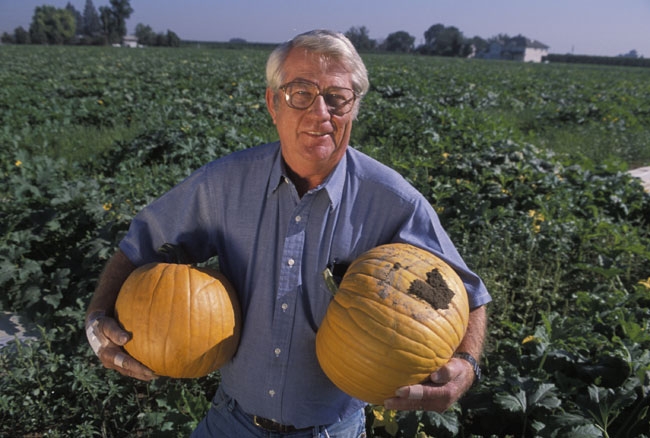
“I started and just kept going,” said Charlie Summers, a research entomologist who was first affiliated with UC Berkeley and later affiliated with UC Davis. Summers ends a 42-year stretch at Kearney when he retires June 30.
Summers grew up on a family farm in Utah and always knew he wanted a career in agriculture. He said he decided at age 12 to go to college, “when I was at the wrong end of a short-handled hoe.”
Summers earned bachelor’s and master’s degrees in zoology and entomology respectively at Utah State University in Logan, Utah, and a doctorate degree in entomology at Cornell in 1970, the same year he started at Kearney.
“The job at Kearney was an absolutely perfect fit for me,” Summers said. “It was a dream job. I look forward to coming to work every morning and would sometimes shake my fist at the sun going down at night. I’ve loved every minute I’ve been here.”
Summers studied a wide range of pest problems in field and vegetable crops. He developed economic thresholds for more than a dozen pests and management strategies for equally as many crops. Among the most challenging pests was the alfalfa weevil, he said. It has been particularly unresponsive to biological control and host plant resistance.
“It is one of the insects that has defied everything we’ve thrown at it except pesticides,” Summers said.
Silverleaf whitefly also posed a tremendous challenge during his career. Silverleaf whitefly was first found in the United States in Florida poinsettia crops during the mid-1980s. Eventually it made its way to a wide range of crops in California, resulting in severe economic losses to growers. Heavy applications of traditional chemicals needed to control the pest caused growers’ costs to increase. The production of some crops ceased altogether because of the extent of silverleaf whitefly damage.
In time, Summers and his colleagues developed a protocol for monitoring and managing the silverleaf whitefly. Light populations are controlled by native and introduced parasites and predators. More severe infestations must still be treated with pesticides.
Another major challenge was the corn leafhopper. The pest first made its way to California in the early 1940s, but didn’t become a serious problem until the end of the 1990s, when it was found to transmit corn stunt disease.
“Corn stunt disease caused plants to form few or no ears of corn. Some farmers’ yields were cut in half,” Summers said. “We worked out a strategy for scheduling planting to avoid the most serious damage. That’s worked out well for growers.”

Crops grown on silver mulch produced significantly higher yields of marketable fruit than did those grown on bare soil, the researchers concluded. Reflective mulch has been used by organic and conventional farmers up and down the valley and in Southern California to grow vegetables. Home gardeners have also applied these research results to garden beds by using aluminum foil as mulch.
Although Summers did not technically have a Cooperative Extension component to his position – he was among the last scientists hired to devote 100 percent of their time to research – Summers made it a point to work closely with farm advisors and specialists to convey research results to farmers.
“Extension work has been one of the most enjoyable things I’ve done,” he said. “I’ve worked with farm advisors on research projects, farm calls and given hundreds and hundreds of extension talks at their grower meetings.”
Summers has also authored more than 200 articles, book chapters and research papers, most of them peer reviewed.
Over the years, Summers said, the objective of his job – to help farmers develop successful pest management strategies – stayed the same, but technological advances dramatically changed the way he did his work.
“We’ve had the advent of computer technology, the use of mathematical models, work that can now be done at the DNA level. It’s put a whole new face on our ability to do research,” he said.
Nevertheless, he said, nothing can replace what he considers the essence of the Agricultural Experiment Station model: to personally assist growers.
“To me that’s the most important job we performed,” Summers said. “I hope this work continues.”
In retirement, Summers plans to move back to Utah to live near his sister and nephews and spend time pursuing his favorite pastime, fly fishing.
“I’ll be living 15 minutes from the Wasatch Mountains,” Summers said. “There’s a lot of good fishing there.”